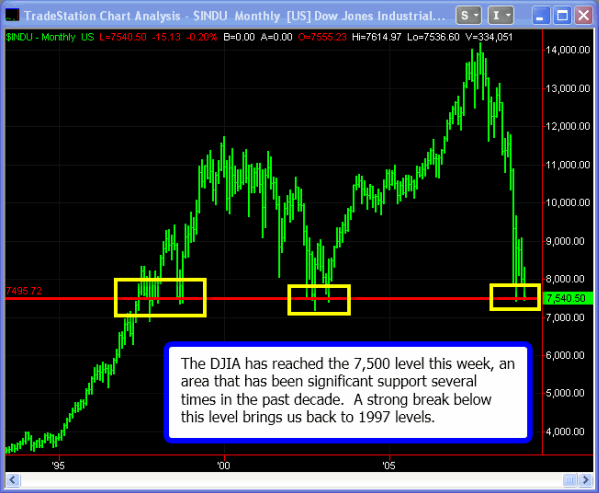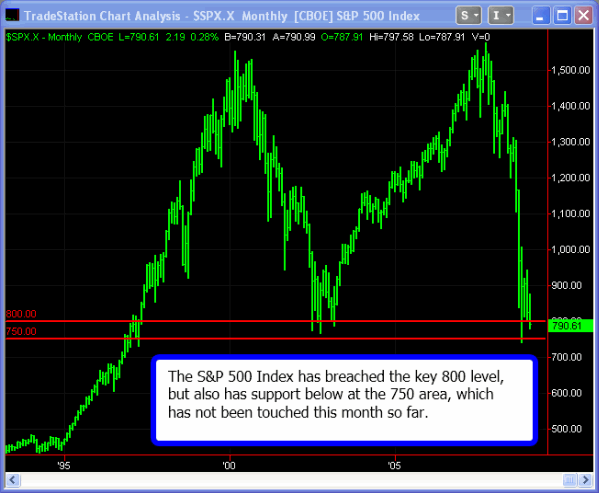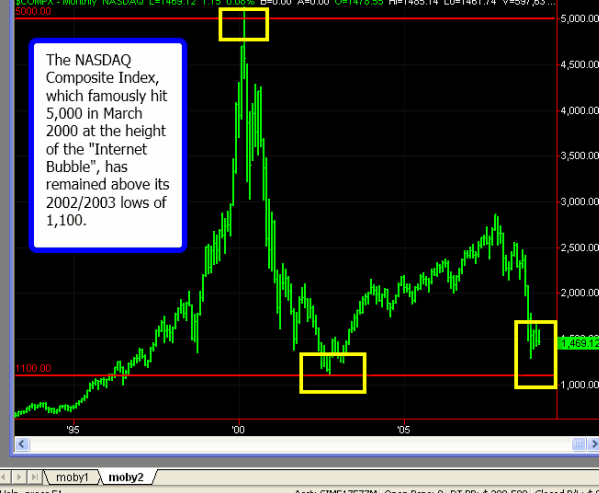| Key Levels For The Major Indices |
| By Price Headley |
Published
02/19/2009
|
Options , Stocks
|
Unrated
|
|
|
|
Key Levels For The Major Indices
Much has been made about the Dow Jones Industrial Average (DJIA) touching the key 7,500 level this week. Why is this level considered important from a historical and technical basis? And what are the other major indices, such as the S&P 500 Index (SPX), NASDAQ 100 Index (NDX), and NASDAQ Composite Index (COMP) showing on a long-term basis?
As you can see in the following chart, this area on DJIA marks the previous lows from November 2008 and 2002-2003 and was also an important technical level in 1997-1998, so it can be considered a strong support level. As you can see the following chart, if we do break sharply below 7,500, we are basically going back to mid-1990s levels in the Index.
DJIA Monthly Chart

The S&P 500 Index (SPX) has breached the 800 level which was significant in the past, but the 750 area is perhaps more important, and we have not yet touched that level this month. We are currently about 5% above that level.
S&P 500 Index Monthly Chart

The NASDAQ 100 Index tracks the performance of the biggest NASDAQ stocks -- this Index almost touched the key 1000 level in November 2008, but currently is about 15% above that level, due to the recent general outperformance of NASDAQ stocks. Some of this is due to the lack of Financial and Energy weighting in NASDAQ Indices.
NASDAQ 100 Index Monthly Chart

The NASDAQ Composite encompasses almost 3,000 NASDAQ listed stocks. The COMP is the Index that famously hit 5,000 in March 2000 at the height of the parabolic uptrend now known as the "Internet Bubble". This Index bottomed around 1,100 in 2002/2003, and thus far we have remained above that level, both currently and in the November 2008 plunge. We currently stand about 25% above 1,100 on the COMP.
NASDAQ Composite Index Monthly Chart

The bottom line is that we are dangerously close to making 12 year+ lows on two of the most widely followed indices, the DJIA and the SPX. However, we do we established support around and just below the current levels which one would anticipate is likely to hold (at least for a trading range consolidation). The NASDAQ indices have withstood the 2008/2009 drop much better ... but from the bearish perspective, they indicate a potential 15% to 25% more downside to their key levels. Of course, these are very long-term charts -- within the big picture multi-year trends are many short-term great trading opportunities on both sides of the market for option traders.
Price Headley is the founder and chief analyst of BigTrends.com.
|